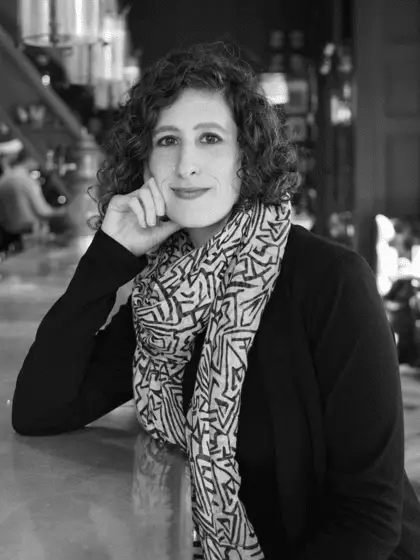While I’m still fairly new to reviewing books, one thing I’ve unconsciously set as a standard is knowing as little about a book as possible going into it. In this case, the only things I knew about The Gold Persimmon before reading it were there is a hotel and the main character works there, maybe? I don’t want to exactly say I’m easy to please, but I absolutely loved it from start to finish. It is unabashedly queer and beautifully written.
Persimmon is the name of a hotel, yes, but that’s more setting the stage. The lobbies, hallways, and offices of hotels are strange places—a place of rest, an escape, safety. Or, to do what consenting adults do, and I think you know what I mean. The book is split between two protagonists, one who works at the Persimmon, a young woman named Clytemnestra, or Cly for short. She almost worships the hotel’s serenity and the customers’ privacy. That is until Edith, sporting a leather jacket and endless confidence, shows up at the hotel and leads her into a whirlwind gay romance.

In Part II, Jaime heads to the Red Orchid for a job interview before becoming trapped along with several others due to a mysterious cloud-like phenomenon over the New York City skyline. It’s got a bit of a similar vibe to The Mist, with a varied group becoming paranoid when confronted with an unexplainable event. The Red Orchid is almost the exact opposite of the Persimmon–it’s a novelty sex hotel with themed rooms. Not only does this add great contrast to Part I, but it also leads to some interesting scenes because you can really have anything in these rooms.
I’m a big fan of “single location” horror. Seeing how people react and learn to deal with things is endlessly interesting. (See The Cabin at the End of the World by Paul Tremblay and We Need to Do Something by Max Booth III for other examples, who both coincidentally also feature queer characters.)
One thing that stood out to me is that Jaime is non-binary and talks about their experiences with their body and how others perceive them. I relate to this quite a lot, and when people put into words how gender dysphoria feels, it hits me right in the gut. “How my voice sometimes betrayed me, another way in which the body required vigilance and management“ might be the most poignant statement about visibly passing I’ve ever read.
I reached out to Lindsay Merbaum to ask her a few questions about her debut novel, which releases October 5th.
Lor Gislason: Several characters in The Gold Persimmon have old-fashioned or unusual names (Clytemnestra, Zosiah, Edison). Was there any reasoning behind this?
Lindsay Merbaum: I choose most names by feel, based on what seems to suit the character, which means sometimes I select a name I’m not particularly fond of, like Edith. But I also like to have some fun with naming characters. And I’m a huge mythology nerd, so I can’t help but make at least a few references.
Clytemnestra is a Greek figure and a rather tragic one. She was married to Agamemnon, whose brother Menelaus started the Trojan War over his wife Helen. In some versions, Agamemnon sacrificed his daughter to appease a petulant god and return the wind to the sea. When he returns from war, Clytemnestra and her lover welcome him, then murder him. That’s a huge sin, even if somewhat justified. In another version, there is no human sacrifice, and the murder of Agamemnon enacts no retribution. Either way, Clytemnestra’s son is fated to kill her for her crime. But I like to imagine how difficult it would’ve been in her position, how little agency she would’ve had, knowing her demise was inevitable. There was just no way she could succeed.
As for Zosiah, the name is also of Greek origin, from “Sophia,” meaning a woman of wisdom. I wanted this character to have an old-school name, something that sounds biblical even if it isn’t and that’s distinctive but not particularly sexy. Also, I’ve always been partial to feminine names starting with ‘Z,’ like Zelda, Zilpha, and Zipporah.
When I lived in Ecuador, I found Edison to be a fairly common name. (I also knew many Washingtons.) I appreciate how this choice might challenge readers’ expectations.

LG: Jaime, the protagonist of Part II, is non-binary and speaks candidly about their experiences. I’m non-binary myself, and I got really emotional during these passages. I don’t think I’ve ever read a book that so accurately put dysphoria into words. So I just wanted to first thank you for that and then ask a bit about how Jaime came to be as a character. Were they NB from the start?
Merbaum: In early drafts, Jaime’s gender identity was never explicitly clarified, leaving the reader to draw their own conclusions. At that point, I thought a lot about Jeanette Winterson’s novel Written on the Body.
As the manuscript developed and Jaime grew as a character, their gender also evolved organically. Then I met my spouse, who identifies as non-binary and transmasculine. I was certainly influenced by what I witnessed in their everyday experience of the world, the way people around them were confused or hostile in response to them. For example, Jaime comments on the masculinity showdown over who opens a door for whom. That’s a microaggression I’ve watched Jen navigate countless times. Getting those details right was very important to me, both for the sake of my readers and because I wanted to do Jaime justice.
LG: Was Jason based on a real person, or a combination of guys? Because he’s such a slimy dude, I feel like I’ve known several people like him. It was like secondhand uncomfortableness when he was in a scene (so, mission accomplished I’d say!).
Merbaum: Jason isn’t based on any particular person. He’s more of a composite of various toxic male traits and tells. Or maybe I’ve just watched The Office too many times, and Dwight Schrute got into my subconscious.
LG: Hotels play a huge role in the story, and I would even argue the locations are a character themselves. What was created first, the Red Orchid or the Gold Persimmon?
Merbaum: I agree the hotels are characters themselves, in a way. Thank you for picking up on that. The Gold Persimmon came first. It was there from the start; it just stood empty for a long time as I tried to figure out this story. At some point, The Red Orchid emerged, and everything started to come together.
LG: Lastly, I just want to say congrats, and I hope the book launch goes well!
Merbaum: Thank you so much!
An early copy of The Golden Persimmon was provided by Creature Publishing for review purposes. The book will be released on October 5th, 2021.
Looking for more horror book reviews? We’ve got you:
“Seeds Is a Delicious Variety Pack of Short Horror Fiction”
“The Beast in Aisle 34 Puts a Modern Spin on Werewolves”
“The Drowning Kind Is an Original Modern Fairy Tale”
“Bradley Sides’ Those Fantastic Lives Is Beautifully Terrifying”
“All the Wrong Ideas Is Jeremy Robert Johnson at His Weirdest”


